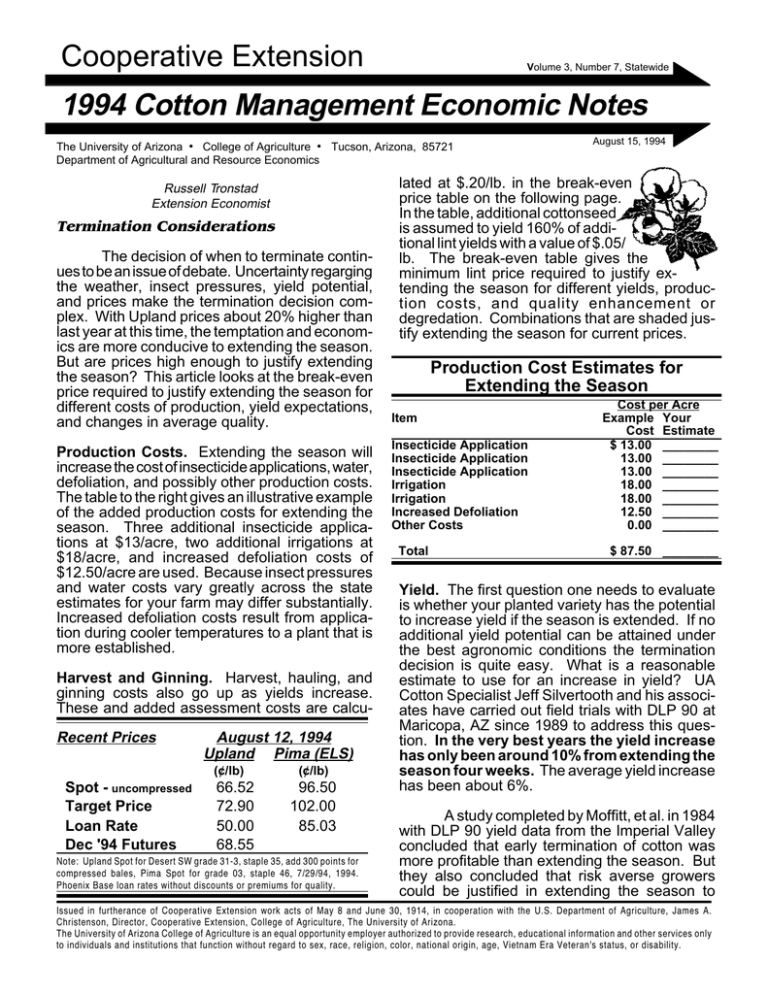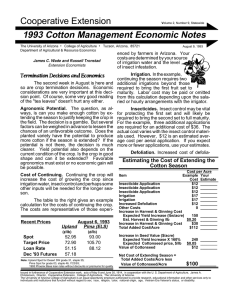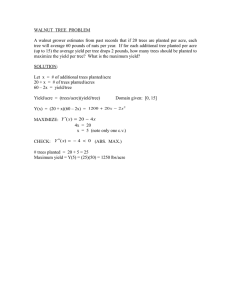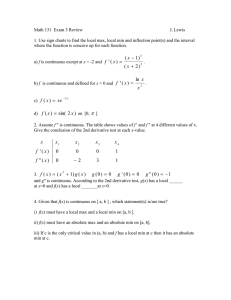Cooperative Extension 1994 Cotton Management Economic Notes •
advertisement

Cooperative Extension Volume 3, Number 7, Statewide 1994 Cotton Management Economic Notes The University of Arizona • College of Agriculture • Tucson, Arizona, 85721 Department of Agricultural and Resource Economics Russell Tronstad Extension Economist Termination Considerations The decision of when to terminate continues to be an issue of debate. Uncertainty regarging the weather, insect pressures, yield potential, and prices make the termination decision complex. With Upland prices about 20% higher than last year at this time, the temptation and economics are more conducive to extending the season. But are prices high enough to justify extending the season? This article looks at the break-even price required to justify extending the season for different costs of production, yield expectations, and changes in average quality. Production Costs. Extending the season will increase the cost of insecticide applications, water, defoliation, and possibly other production costs. The table to the right gives an illustrative example of the added production costs for extending the season. Three additional insecticide applications at $13/acre, two additional irrigations at $18/acre, and increased defoliation costs of $12.50/acre are used. Because insect pressures and water costs vary greatly across the state estimates for your farm may differ substantially. Increased defoliation costs result from application during cooler temperatures to a plant that is more established. Harvest and Ginning. Harvest, hauling, and ginning costs also go up as yields increase. These and added assessment costs are calcu- Recent Prices August 12, 1994 Upland Pima (ELS) (¢/lb) Spot - uncompressed Target Price Loan Rate Dec '94 Futures 66.52 72.90 50.00 68.55 (¢/lb) 96.50 102.00 85.03 Note: Upland Spot for Desert SW grade 31-3, staple 35, add 300 points for compressed bales, Pima Spot for grade 03, staple 46, 7/29/94, 1994. Phoenix Base loan rates without discounts or premiums for quality. August 15, 1994 lated at $.20/lb. in the break-even price table on the following page. In the table, additional cottonseed is assumed to yield 160% of additional lint yields with a value of $.05/ lb. The break-even table gives the minimum lint price required to justify extending the season for different yields, production costs, and quality enhancement or degredation. Combinations that are shaded justify extending the season for current prices. Production Cost Estimates for Extending the Season Item Insecticide Application Insecticide Application Insecticide Application Irrigation Irrigation Increased Defoliation Other Costs Total Cost per Acre Example Your Cost Estimate $ 13.00 ________ 13.00 ________ 13.00 ________ 18.00 ________ 18.00 ________ 12.50 ________ 0.00 ________ $ 87.50 ________ Yield. The first question one needs to evaluate is whether your planted variety has the potential to increase yield if the season is extended. If no additional yield potential can be attained under the best agronomic conditions the termination decision is quite easy. What is a reasonable estimate to use for an increase in yield? UA Cotton Specialist Jeff Silvertooth and his associates have carried out field trials with DLP 90 at Maricopa, AZ since 1989 to address this question. In the very best years the yield increase has only been around 10% from extending the season four weeks. The average yield increase has been about 6%. A study completed by Moffitt, et al. in 1984 with DLP 90 yield data from the Imperial Valley concluded that early termination of cotton was more profitable than extending the season. But they also concluded that risk averse growers could be justified in extending the season to Issued in furtherance of Cooperative Extension work acts of May 8 and June 30, 1914, in cooperation with the U.S. Department of Agriculture, James A. Christenson, Director, Cooperative Extension, College of Agriculture, The University of Arizona. The University of Arizona College of Agriculture is an equal opportunity employer authorized to provide research, educational information and other services only to individuals and institutions that function without regard to sex, race, religion, color, national origin, age, Vietnam Era Veteran's status, or disability. Break-Even Prices for Extending the Season With a Base Yield of 1200 lbs./acre Additional Production Costs ($/Acre) $.02/lb. average improvement in quality Additional Yield (lbs./Acre) 10 25 50 75 100 150 200 25 50 100 150 200 250 ----------------------- $/lb. -------------------------0.46 -0.18 -0.04 0.01 0.03 0.04 0.14 0.12 0.11 0.11 0.11 0.10 1.14 0.62 0.36 0.27 0.23 0.20 2.14 1.12 0.61 0.44 0.36 0.30 3.14 1.62 0.86 0.61 0.48 0.40 5.14 2.62 1.36 0.94 0.73 0.60 7.14 3.62 1.86 1.27 0.98 0.80 Additional Production Costs ($/Acre) no change in quality for all cotton Additional Yield (lbs./Acre) 10 25 50 75 100 150 200 25 50 100 150 200 250 ----------------------- $/lb. ------------------------0.52 0.32 0.22 0.19 0.17 0.16 1.12 0.62 0.37 0.29 0.25 0.22 2.12 1.12 0.62 0.45 0.37 0.32 3.12 1.62 0.87 0.62 0.50 0.42 4.12 2.12 1.12 0.79 0.62 0.52 6.12 3.12 1.62 1.12 0.87 0.72 8.12 4.12 2.12 1.45 1.12 0.92 Additional Production Costs ($/Acre) $.02/lb. average degredation in quality Additional Yield (lbs./Acre) 10 25 50 75 100 150 200 25 50 100 150 200 250 ----------------------- $/lb. ------------------------1.50 0.82 0.48 0.37 0.31 0.28 2.10 1.12 0.63 0.47 0.39 0.34 3.10 1.62 0.88 0.63 0.51 0.44 4.10 2.12 1.13 0.80 0.64 0.54 5.10 2.62 1.38 0.97 0.76 0.64 7.10 3.62 1.88 1.30 1.01 0.84 9.10 4.62 2.38 1.63 1.26 1.04 Additional Production Costs ($/Acre) $.04/lb. average degredation in quality Additional Yield (lbs./Acre) 25 50 100 150 200 250 ----------------------- $/lb. ------------------------10 2.48 1.32 0.74 0.55 0.45 0.39 25 3.08 1.62 0.89 0.65 0.53 0.45 50 4.08 2.12 1.14 0.81 0.65 0.55 75 5.08 2.62 1.39 0.98 0.78 0.65 100 6.08 3.12 1.64 1.15 0.90 0.75 150 8.08 4.12 2.14 1.48 1.15 0.95 200 10.08 5.12 2.64 1.81 1.40 1.15 Note: Harvest and ginning costs are assumed at $.20/ lb. for additional production. The increase in cottonseed yield is calculated at 160% of additional lint yield and assumed to be worth $.05/lb. reduce yield and hence income variability. Quality deterioration was not included in their analysis and this risk may outweigh the risk associated with yield variation. Quality. A base yield of 1,200 lbs. is used in the example. Because the entire crop quality has the potential to be altered from extending the season, a base yield is needed to calculate break-even prices. An additional yield of 100 lbs. implies a total yield of 1,300 lbs. and a fairly optimistic 8.3% yield increase. Break-even price tables to the left have four different quality adjustments from extending the season. A $.02/lb. increase in the base and additional lint yield is shown in the top table. This senario is probably not likely to happen but illustrates the importance of bringing the crop to maturity, at least to the point of avoiding immature fibers. The second table assumes that average quality remains unchanged for extending the season. Additional production costs were calculated at $87.50/acre in the example on the previous page. Because break-even prices are linear with respect to production costs, a minimum price of 99.5¢/lb. is needed to justify extending the season for an additional 100 lbs. If your additional production costs are estimated at $60/ acre, a minimum price of 72¢/lb. (15/25 x .62 + 10/ 25 x .87) is needed to extend the season for 100 lbs., assuming no change in quality from extending the season. Gray and light gray percentages for all cotton classed in the Phoenix classing office have increased from about 5% for classing dates in September and October to over 20% for classing dates in December the last two years. This kind of quality degradation could easily drop your average price by 2 to 4 cents a pound. If you extend the season for $75/acre, receive 200 additional pounds of lint, experience no quality degredation, and receive a base lint price of 66¢/ lb. you would make $32/acre (i.e., (.66 - .50) x 200). But if weather and insect damages dropped your average quality by $.04/lb. you would lose about $24/acre (i.e., (.66 - .78) x 200). Risk-Return Assessment. If the economics look conducive for extending the season with no change in quality, a strategy of extending the season on part of your acreage may be wise. Returns have the potential to be enhanced while keeping financial risks manageable. When millionaire Paul Getty was asked how he made his fortune he responded by saying that he never tried to be too greedy and make a fortune on any investment but just a little on each investment. Disclaimer: Neither the issuing individuals, originating unit, Arizona Cooperative Extension, nor the Arizona Board of Regents warrant or guarantee the use or results of this publication issued by the Arizona Cooperative Extension and its cooperating Departments and Offices.






